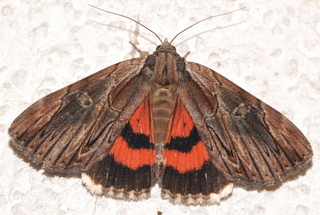|
As a collective network, we plan to have fun studying moths and other creatures of the night.
How are the biologies of plants and their insect pollinators synchonized?
How do temperature and other factors affect them?
Do moth species fly in the same order each year?
By photographing and recording species activity at different sites across the continent,
we will be able to assess how species respond to important environmental variables.
In conjunction with similar data on plant flowering, lichens, and other indicator groups,
we will be able to predict the impact of potential long-term changes on communities
of species and their interactions.
|
|

Catocala ultronia (Hübner, 1823), Ultronia Underwing
|
|
Protocol
-
Invite friends to arrive at sunset (or don't, if you have no friends
or prefer to commune with moths alone).
-
Serve drinks; snacks optional.
-
Switch on your porch light before it gets dark.
-
Go to Albums for instructions
about how to use your camera and upload images.
-
Watch our great
5-minute video
(aimed at Bee Hunt, but unless you've already had too many drinks, should explain the basics of collecting high-quality data for moths too).
-
Have each participant with a camera take a photograph of
their cell phone (as a check of their cameras' date/time).
-
Also, photograph your GPS (if you have one) and a
landmark, e. g., your porch light.
-
Repeat step (2).
-
Wait, talk, and laugh.
-
Take a photograph of each species (moths, ladybugs, flies, ...
frogs... friends) that comes to the lights (as many species as you can each night).
-
Take another one with a ruler (in millimeters if available). Size does matter.
-
Upload photos at the end of the evening, or next day,
if it is a long, fun evening. Document where and when.
Identify what you can -- a crowd, our computers, and some experts will ultimately
help you.
-
Share this link with your friends. (For analysis purposes, we need frequent data from each site or each cluster of neighboring sites.)
-
Check your album's 'life list' feature. (Is mine bigger than yours?)
More information
Contact information
We're utterly addicted. Please join us and have fun too.
- To set up an album and for outreach and educational activities
Nancy Lowe -- email: nancy@discoverlife.org -- telephone: USA-404-272-4526
|